
A single-lens reflex camera (SLR) is a camera that typically uses a mirror and prism system that permits the photographer to view through the lens and see exactly what will be captured. With twin lens reflex and rangefinder cameras, the viewed image could be significantly different from the final image. When the shutter button is pressed on most SLRs, the mirror flips out of the light path, allowing light to pass through to the light receptor and the image to be captured.
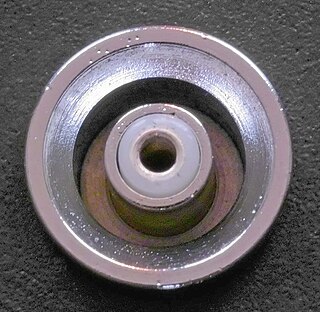
In a camera, flash synchronization is defined as synchronizing the firing of a photographic flash with the opening of the shutter admitting light to photographic film or electronic image sensor. It is often shortened to flash sync or flash synch.
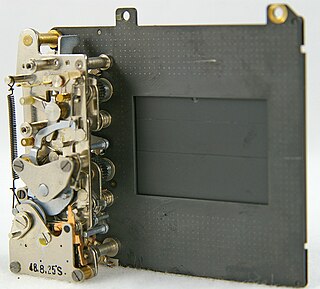
In camera design, a focal-plane shutter (FPS) is a type of photographic shutter that is positioned immediately in front of the focal plane of the camera, that is, right in front of the photographic film or image sensor.

The Nikon FE is an advanced semi-professional level, interchangeable lens, 35 mm film, single-lens reflex (SLR) camera. It was manufactured by Nikon in Japan from 1978 to 1983, and was available new from dealer stock until c. 1984. The FE uses a metal-bladed, vertical-travel focal plane shutter with a speed range of 8 to 1/1000 second, plus Bulb, and flash X-sync of 1/125th second. It had dimensions of 89.5 millimetres (3.52 in) height, 142 mm (5.6 in) width, 57.5 mm (2.26 in) depth and 590 grams (21 oz) weight. It was available in two colors: black with chrome trim and all black. As on the FM, its model designation did not appear on the front of the camera, but was engraved as a small "FE" preceding the serial number on the rear of the housing.

The Canon A-1 is an advanced level single-lens reflex (SLR) 35 mm film camera for use with interchangeable lenses. It was manufactured by Canon Camera K. K. in Japan from April 1978 to 1985. It employs a horizontal cloth-curtain focal-plane shutter with a speed range of 30 to 1/1000 second plus bulb and flash synchronization speed of 1/60 second. It has dimensions of 92 millimetres (3.6 in) height, 141 millimetres (5.6 in) width, 48 millimetres (1.9 in) depth and 620 grams (22 oz) weight. Unlike most SLRs of the time, it was available in only one color; all black. The introductory US list price for the body plus Canon FD 50 mm f/1.4 SSC lens was $625, the camera was generally sold with a 30–40% discount.

The Canon AE-1 is a 35 mm single-lens reflex (SLR) film camera for use with interchangeable lenses. It was manufactured by Canon Camera K. K. in Japan from April 1976 to 1984. It uses an electronically controlled, electromagnet horizontal cloth focal plane shutter, with a speed range of 2 to 1/1000 second plus Bulb and flash X-sync of 1/60th second. The camera body is 87 mm tall, 141 mm wide, and 48 mm deep; it weighs 590 g. Most are black with chrome trim, but some are all black.

The Canon EOS 5 is a semi-professional autofocus, autoexposure 35 mm SLR film camera. It was sold from November 1992 onwards, and was replaced in late 1998 by the Canon EOS 3. As part of the EOS line of cameras, the 5/A2/A2e utilized Canon's EF bayonet lens mount, first introduced in 1987.

The Canon T50, introduced in March 1983 and discontinued in December 1989, was the first in Canon's new T series of 35mm single-lens reflex cameras compatible with Canon's FD lens mount. SLR sales were falling in 1983 from the market's 1981 peak, and Canon chose to try greater automation to revive sales and remain competitive. This approach had found favor in compact cameras such as the AF35M "Autoboy" (Japan) or "Sure Shot" (US). The T50 had a power winder built in giving a continuous shooting rate of 1.4 frames per second, as well as an advanced auto-exposure mode, although it was still a manual focus camera. Unlike those compact cameras and the higher-end models in the T series, the T50 did not have power rewind, relying on a manual crank. The camera's electric systems were powered by two AA batteries in the grip, which gave enough power to shoot 75 24-exposure rolls, or 50 36-exposure rolls.
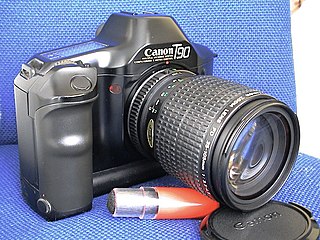
The Canon T90, introduced in 1986, was the top of the line in Canon's T series of 35 mm Single-lens reflex (SLR) cameras. It is the last professional-level manual-focus camera from Canon, and the last professional camera to use the Canon FD lens mount. Although it was overtaken by the autofocus revolution and Canon's new, incompatible EOS after only a year in production, the T90 pioneered many concepts seen in high-end Canon cameras up to the present day, particularly the user interface, industrial design, and the high level of automation.
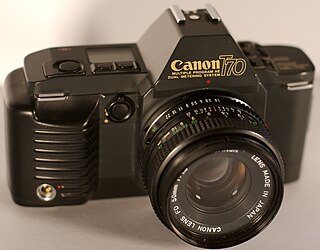
The Canon T70 was a 35mm FD-mount single-lens reflex camera introduced in April 1984 as the second in Canon's T series. The T70 started with the concepts explored in 1983's T50, took them further, and applied them to a more sophisticated camera. While the Program AE-only T50 was intended as a beginner's camera, the T70 gave the photographer a lot more control over the camera's operation while keeping the T-series philosophy of simplicity in control and operation intact.
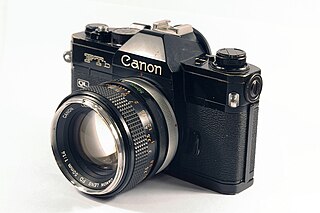
The Canon FTb is a 35 mm single-lens reflex camera manufactured by Canon of Japan from March 1971 replacing the Canon FT QL. It features a Canon FD lens mount, and is also compatible with Canon's earlier FL-mount lenses in stop-down metering mode. Launched alongside the top-of-the-line F-1, the FTb was the mass-market camera in the range.

The Canon FT QL is a 35mm single-lens reflex camera introduced by Canon of Japan in March 1966. It has a Canon FL lens mount compatible with the large range of FL series lenses. The FT can also operate the later Canon FD series lenses in stop-down mode, but the earlier R series has a different lens aperture mechanism and cannot be used, although the bayonet fitting is similar. The standard kit lenses were Canon's 50mm f/1.8 ; 50mm f/1.4 and 58mm f/1.2, the body-only option was offered later.
The Olympus OM System was a line of 35mm single-lens reflex cameras, lenses and accessories sold by Olympus between 1972 and 2002.

Nikkormat was a brand of cameras produced by the Japanese optics company Nippon Kogaku K. K., as a consumer version of the professional Nikon brand. Nikkormat cameras, produced from 1965 until 1978, were simpler and more affordable than Nikon-branded cameras, but accepted the same lenses as the Nikon F series cameras.
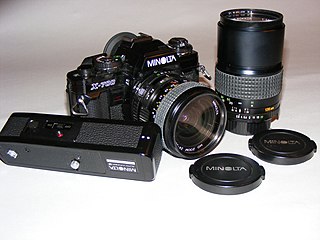
The Minolta X-700 is a 35 mm single-lens reflex film camera introduced by Minolta in 1981. It was the top model of their final manual-focus SLR series before the introduction of the auto-focus Minolta Maxxum 7000.

The Olympus OM-4 is an interchangeable-lens, 35 mm film, single lens reflex (SLR) camera; manufactured by Olympus Optical Co., Ltd. in Japan, and sold as OM-4 from 1983 to 1987 and as OM-4Ti from 1986 to 2002.
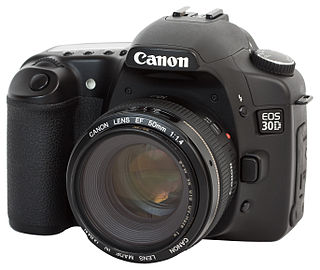
The Canon EOS 30D is an 8.2-megapixel semi-professional digital single-lens reflex camera, initially announced on February 21, 2006. It is the successor of the Canon EOS 20D, and is succeeded by the EOS 40D. It can accept EF and EF-S lenses, and like its predecessor, it uses an APS-C sized image sensor, so it does not require the larger imaging circle necessary for 35 mm film and 'full-frame' digital cameras.
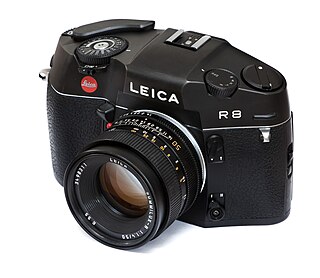
The Leica R8 & R9 are manual focus 35 mm single-lens reflex cameras produced by the German firm Leica as the final models of their R series. Development of the R8 began in 1990: the camera was introduced at the 1996 photokina trade show, and was succeeded by the similar Leica R9 in 2002.

The Canon FX is a 35 mm SLR manufactured by Canon Inc. of Japan and introduced in April 1964. It introduced the Canon FL lens mount, the successor to the Canon R.

The Canon EOS 100 is a 35 mm autofocus SLR camera introduced by Canon in 1991. It was marketed as the EOS Elan in North America. It was the second camera in the EOS range to be targeted at advanced amateur photographers, replacing the EOS 650.





















